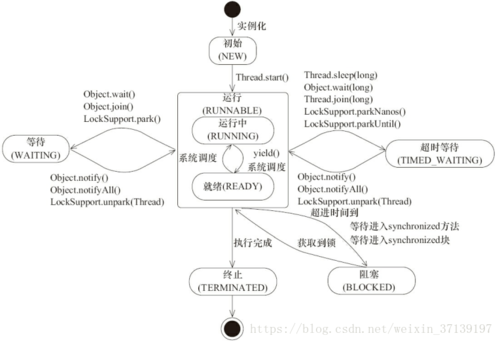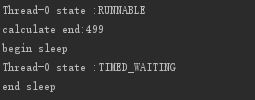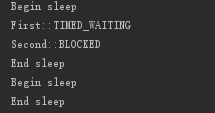线程状态 Thread.State
状态类型
在指定的时间点, 一个线程有且只有一种状态。 这些状态是 JVM 的状态, 他们并没有反映操作系统的状态。
定义
Thread 的状态是定义在 Thread 内部的枚举类型。
public enum State {
NEW,
RUNNABLE,
BLOCKED,
WAITING,
TIMED_WAITING,
TERMINATED;
}在定义中, 我们知道共有 6 种类型。
说明
| 状态 | 说明 |
|---|---|
| NEW | 至今尚未启动的线程处于这种状态 |
| RUNNABLE | 正在 Java 虚拟机中执行的线程处于这种状态。 因为可能在等待其他的资源, 比如处理器。 |
| BLOCKED | 受阻塞并等待某个监视器锁的线程处于这种状态 |
| WAITING | 无限期地等待另一个线程来执行。某一特定操作的线程处于这种状态 |
| TIMED_WAITING | 等待另一个线程来执行。取决于指定等待时间的操作的线程处于这种状态 |
| TERMINATED | 已退出的线程处于这种状态 |
状态转换
借用 《Java 并发编程的艺术》图一张
从以上的图可以看出,
线程创建后未启动未 「NEW」 状态, 通过 start() 函数转换为 「RUNNABLE」状态。
「RUNNABLE」 状态通过各函数, 可以与「WAITING」、「TIMED-WAITING」、「BLOCKED」 进行双向切换。
「RUNNABLE」 状态在线程结束后转换为 「TERMINATED」 状态。
也就是说, 全部的状态是以 「RUNNABLE」 为中心的。
状态验证
「NEW」-> 「RUNNABLE」 -> 「TERMINATED」
创建一个实现 Runnable 的类
public class StateTestThread implements Runnable{ public StateTestThread() { // 此时的线程还是 main
System.out.println(Thread.currentThread().getName()+" state in Constructor:"+
Thread.currentThread().getState());
} public void run() {
System.out.println(Thread.currentThread().getName()+" state in Run:"+
Thread.currentThread().getState());
}
}创建一个测试类
public class ThreadStateTest { public static void main(String[] args) {
StateTestThread stateTestThread = new StateTestThread();
Thread thread = new Thread(stateTestThread);
System.out.println(thread.getName()+" state after constructor:"
+thread.getState()); try {
Thread.sleep(1000L);
thread.start();
Thread.sleep(1000L);
System.out.println(thread.getName()+" state after run:"
+thread.getState());
} catch (InterruptedException e) {
e.printStackTrace();
}
}
}运行结果
「RUNNABLE」 -> 「TIMED_WAITING」
public class ThreadStateTest { public static void main(String[] args) {
Thread thread = new Thread(new Runnable() { public void run() { long begin = System.currentTimeMillis(); for (int i = 0; i < (1 << 25); i++) { int j = (int) Math.sqrt(i); // 该条件永远不成立, 只是为了计算
if (j * j > i) { break;
}
} long end = System.currentTimeMillis();
System.out.println("calculate end:"+(end - begin)); try {
System.out.println("begin sleep");
Thread.sleep(5000L);
System.out.println("end sleep");
} catch (InterruptedException e) {
e.printStackTrace();
}
}
}); try {
thread.start();
Thread.sleep(100L);
System.out.println(thread.getName()+" state :"
+thread.getState());
Thread.sleep(1000L);
System.out.println(thread.getName()+" state :"
+thread.getState());
} catch (InterruptedException e) {
e.printStackTrace();
}
}
}结果如下:
Thread-0 的状态从 「RUNNABLE」 转化为 「TIMED_WAITING」
「RUNNABLE」 -> 「WAITING」
public static void main(String[] args) {
Thread thread = new Thread(new Runnable() {
final Object lock = new Object(); public void run() {
synchronized (lock) { try { lock.wait();
} catch (InterruptedException e) {
}
}
}
});
thread.start();
System.out.println(thread.getName()+" state :"
+thread.getState()); try {
Thread.sleep(1000L);
} catch (InterruptedException e) {
e.printStackTrace();
}
System.out.println(thread.getName()+" state :"
+thread.getState());
}运行结果
「RUNNABLE」 -> 「BLOCKED」
先创建一个 Runnable 子类
public static void main(String[] args) {
Thread thread = new Thread(new Runnable() {
final Object lock = new Object(); public void run() {
synchronized (lock) { try { lock.wait();
} catch (InterruptedException e) {
}
}
}
});
thread.start();
System.out.println(thread.getName()+" state :"+thread.getState()); try {
Thread.sleep(1000L);
} catch (InterruptedException e) {
e.printStackTrace();
}
System.out.println(thread.getName()+" state :"+thread.getState());
}测试方法
public static void main(String[] args) {
BlockedStateRun blockedStateRun = new BlockedStateRun();
Thread thread1= new Thread(blockedStateRun);
Thread thread2= new Thread(blockedStateRun);
thread1.setName("First");
thread1.start();
thread2.setName("Second");
thread2.start(); try {
Thread.sleep(200L);
System.out.println(thread1.getName()+"::"+thread1.getState());
System.out.println(thread2.getName()+"::"+thread2.getState());
} catch (InterruptedException e) {
e.printStackTrace();
}
}最后的运行结果:
原文出处:https://www.cnblogs.com/homejim/p/9545581.html
点击查看更多内容
为 TA 点赞
评论
共同学习,写下你的评论
评论加载中...
作者其他优质文章
正在加载中
感谢您的支持,我会继续努力的~
扫码打赏,你说多少就多少
赞赏金额会直接到老师账户
支付方式
打开微信扫一扫,即可进行扫码打赏哦









